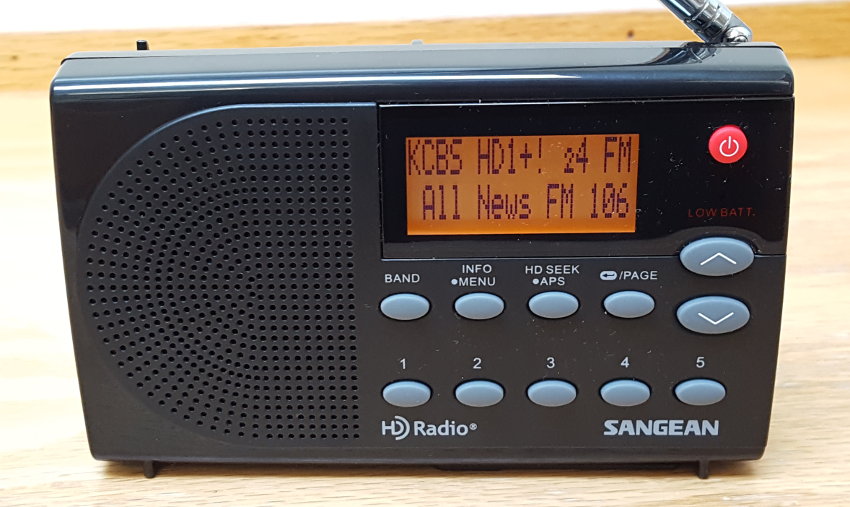
While HD radio receivers have been around since 2004, very few of them could be considered portable. For years, the compact FM-only Insignia NS-HD01 was one of the few portable options. In 2018, though, Sangean released several HD-equipped models, including the travel-sized portable HDR-14. This model fits in the same niche as many of the other portable DSP-based radios that I've reviewed. Sangean has an entire line of HD radios, including a larger portable "boom box" style radio and a component receiver that's the successor to the HDT-1 and HDT-1X models. It was still available in 2024, when this review was revised.
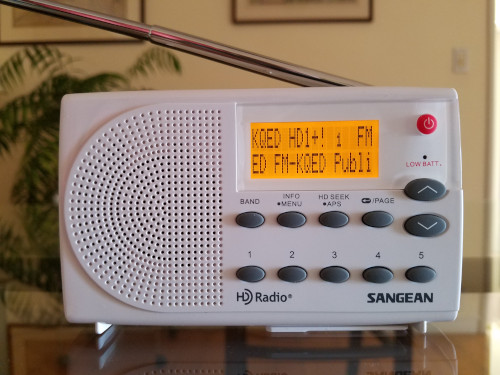
In early 2021, Sangean released another portable HD radio, the SG-108, with a mostly white cabinet. Sangean's published specifications for the SG-108 are identical to the HDR-14. The placement of controls, the speaker, the battery compartment, and the small plastic stand are identical between the models. After acquiring an SG-108, I was able to confirm that the radios are, in fact, functionally identical. The only difference is that the HDR-14 has a black cabinet with white lettering while the SG-108's cabinet is white with gray accents and black lettering.
All subsequent references in this review to the HDR-14's features and performance are equally applicable to the SG-108. For convenience, I'll just refer to the HDR-14.
During the 2010's, the growth of HD Radio appeared to level off. While broadcasters staked their claim to a digital future through the hybrid analog/digital system, satellite radio and Internet-based audio streams became competitive as well. While an increasing number of vehicles featured HD-reception capability, truly portable radios with HD capability were not common.
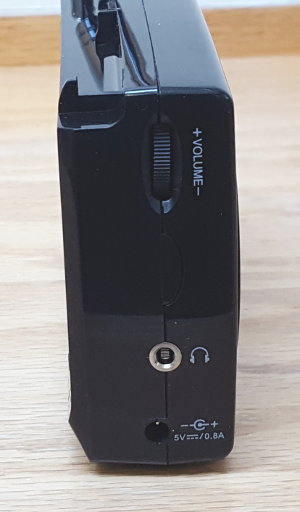
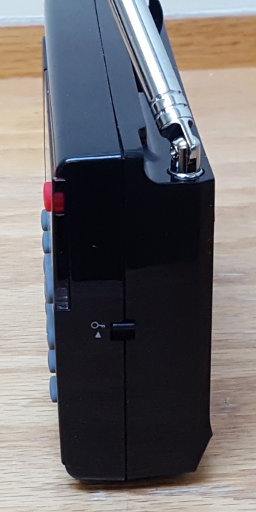
The HDR-14 fills that gap nicely. It's around the same size as other DSP-based radios with a speaker: 5" wide by 3" high by 1 1/4" deep. Tuning is done either with up-and-down buttons or memory presets. There is no tuning dial, nor any form of direct keyboard entry. When a station with one or more HD channels is tuned, the radio first locks on to the station's analog channel while acquiring enough data for a digital stream. An HD indicator flashes until the radio has switched over to digital operation.
Most controls are simple: a volume control and stereo headphone jack on the left side of the unit (far left), a lock switch on the right side (near left), four buttons for various purposes, and five memory buttons.
While the lock switch is simple to use, there is a minor lapse in its design, in my opinion. There is no indication on the display panel that the lock is on. In part, this is due to the fact that the display panel is, by default, on only when the radio is on, unlike many other DSP-based radios. (This can be changed in the radio's settings.) Perhaps this is done to keep from draining the three AA-size batteries. The radio does not recharge batteries, but an AC adapter is included. But the lack of any indication that the controls are locked means that, if you don't look carefully, you may try to press the power switch and then find that nothing happens. As a consequence, you might think that the batteries need changing, while, in reality, it's just the lock switch that's keeping the radio from turning on. This happened to me once, and, instead of looking for the lock switch, I thought the batteries were flat. So I changed them, even though I probably didn't need to.
Power consumption and battery life, a problem with earlier HD radios, doesn't appear to be a problem with the HDR-14. Batteries will last a reasonable amount of time in this radio.
There's a quirk with the power switch, too. You have to press it quickly in order for it to work. If you press and hold down the power switch, the radio won't turn on.
The display
The display is a simple dot-matrix style display. There is a yellow backlight that comes on for about two seconds after pressing any button. There is no separate switch or button for turning the backlight on. The "Artist Experience" feature available on some HD stations for displaying album cover art or station logos isn't supported, doubtless because of the expense involved in having a display screen that would be more complex than the simple dot-matrix display on this unit.
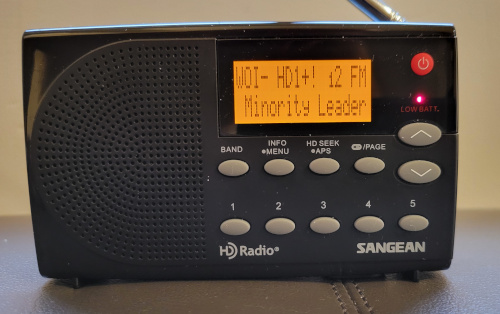
There's no battery indicator in the display. Instead, a tiny red LED just under the power switch will light up when the battery capacity is low (see left). You can see the light just below the red power button. The "LOW BATT" legend under the light is barely visible.
The indicator turned on for me while I happened to be in Des Moines, Iowa; hence the display shows reception from Iowa Public Radio's WOI-FM in nearby Ames, one of the oldest FM stations in Iowa, and associated with one of the oldest AM stations in the United States.
More about the display: the INFO button toggles the lower line of the display to show the following information:
- Station information with song artist and title (if applicable)
- Station frequency
- Type of programming
- Time (if it has been set)
- Date (if it has been set)
- Mono or Stereo (FM only)
- Signal strength, shown by a series of bars
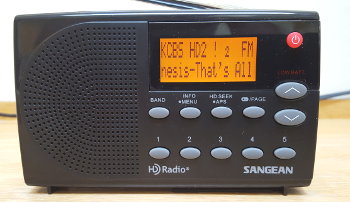
The first four characters in the upper line of the display are used for the station's call letters or a very short slogan. For example, San Francisco's KYLD(FM) used "WILD" in that space rather than "KYLD". KFRC-FM, which simulcasted KCBS(AM), used "KCBS", even for its HD-2 channel that otherwise identified as "KFRC" on the air! (The KFRC-HD2 channel was discontinued in February 2023 in a cost-cutting move; KFRC-FM still simulcasts KCBS.)
Tuning HD channels
In the center of the upper line when the station being tuned broadcasts an HD digital signal, the display can show HD, followed by the number of the HD channel, followed by a + if additional HD channels are available, followed by an exclamation point if the radio is using the digital signal.
When in HD mode, the up and down tuning buttons are used to select the desired HD channel. The number of channels is totally at the originating station's discretion, though the HD-1 channel must broadcast the same material as the station's analog signal. Up to three additional channels (HD-2, HD-3, HD-4) are possible. Since an HD broadcast has limited data capacity, additional channels can reduce the audio quality of the audio being transmitted on some or all channels.
The + indicator shows whether higher-numbered HD channels are available. When it is no longer present, pressing the up button causes the radio to tune to the next higher frequency. Pressing the down button when tuned to an HD-1 channel causes the radio to tune to the next lower frequency. This may seem obvious, and it's not confusing in practice, but you do have to pay attention when listening to a station broadcasting more than one HD channel to determine whether you'll be tuning to another channel of the same station, or to a different station altogether.
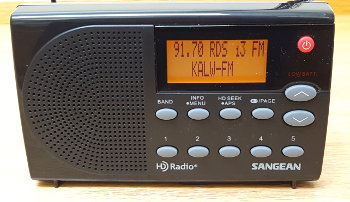
For a station broadcasting in analog only, the radio will try to determine if RDS (Radio Data System) information is available. If it is, RDS will be displayed in the center of the upper line. Otherwise, nothing is displayed there.
Other controls
The INFO button cycles through RDS information in a similar manner to the manner in which the information provided by a station broadcasting in HD is displayed.
The smaller number toward the right center of the upper line indicates a memory page. The PAGE button is used to cycle through four memory pages with five positions each. Thus there are 20 memory presets for each band, AM and FM.
The BAND button switches between AM and FM. Holding down the INFO button brings up a menu of additional settings. Searching functions are on the next button to the right. The rightmost button, the PAGE button, is also used to set the time and date on the radio. It's important to read the instruction manual to see how this is done; it's not obvious.
The radio can also be set to use RDS signals to set the clock automatically. In practice, I have found that some stations provide the incorrect time, usually the wrong time zone, with this method. I always set the time and date manually as a result.
Two alarms are provided. They're set through the menu of additional settings accessible through the INFO button. The alarms are easy enough to set, though you also have to set the station that you want to use for the purpose in advance. In other words, the alarm doesn't come on for the last station you listened to; you have to plan it in advance! This is increasingly common among portable radios of this type. I guess it's considered a feature, but I don't think much of it. One thing that's very nice is that, when the alarm goes off, the radio's audio volume ramps up gradually until reaching the volume that you had previously set. Sangean calls this the Humane Waking System. When the alarm is set, either "A1" or "A2" will show on the display. A sleep timer is also available through the menu.
Not shown, but a very handy feature, is a small swiveling stand at the bottom of the radio, used to stablize it on a flat surface.
Performance
On FM, reception performance is nearly identical to other DSP-based radios, though it's less selective due to the wider bandwidth necessary to accomodate HD signals. Performance would also be better if the rod antenna were the correct length. It's 25 inches long rather than the 30 inches optimal for FM reception. On AM, there are better choices. In a head-to-head comparison with three other DSP radios, the HDR-14 received the fewest stations clearly. From a location in Paso Robles, California, chosen because there's only one local AM station there, a head-to-head comparison with three radios plus the HDR-14 yielded these results:
- Digitech AR-1780: 43 stations
- Tecsun PL-380: 36 stations
- Radiwow R-108:: 34 stations
- Sangean HDR-14: 30 stations
The HDR-14 is a good radio, but, purely on the basis of reception and AM audio performance, other radios are better. On the other hand, the HDR-14 and its near-identical twin, the SG-108, are the only portable radios that I know of with AM HD reception capability. FM performance is roughly equal to the other three units, with minor variations on individual stations that may just be natural small variations in signal propagation.
How does the HDR-14 sound? On FM, just like any other radio. The built-in speaker has a reasonably good tonal range for its size, and seems to have a little bit of extra capability at both lower and higher audio frequencies. Its sound is similar to the Digitech AR-1780, though I prefer the sound of the Digitech's built-in speaker.
For an AM analog signal, the audio bandwidth appears to be limited to 4 kHz. This is typical. Not so typical is the very aggressive automatic gain control (AGC). This radio's AGC features a very rapid response to changes in signal strength, which has some effect on musical programming. It does mean that audio recovery is excellent, but I don't think it would be pleasant to listen to music for a long time on the HDR-14. Spoken-word programming should be fine.
AM HD digital reception
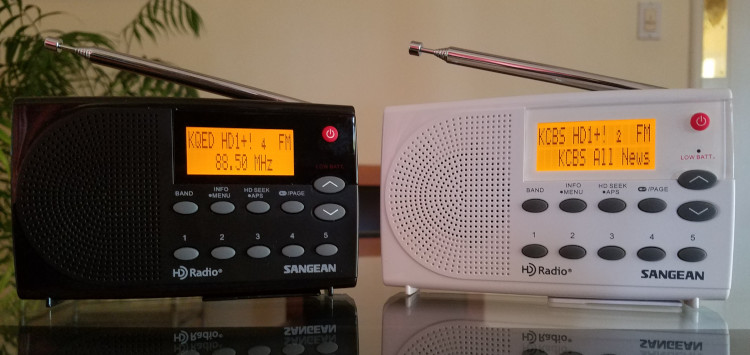
It's more difficult for me to speak to the sound quality of an AM HD signal (in "hybrid" mode, where both a digital and analog signal are broadcast) on this radio, because there were no AM HD stations in the Bay Area as of the end of 2019, when this review was written.
I had to travel to Denver in order to find AM stations broadcasting in HD mode. I found that the low bitrate available on the digital stream of a hybrid-mode AM HD signal caused unpleasant artifacts to appear in the sound. This radio may not come into its own, as far as AM stations are concerned, unless all-digital AM broadcasting becomes more widespread.
In 2019, a Washington, D.C.-area station began experimenting with an all-digital signal. Late in 2019, based on that experiment, and others that were short-lived, the Federal Communications Commission (FCC) began a rulemaking regarding all-digital AM-band broadcasting. In October 2020, the FCC approved all-digital AM broadcasting on a voluntary basis.
Under the new rules, an AM station can stop analog broadcasting and, instead, operate a single digital channel (the MA3 mode, which all current AM stereo receivers can decode), but will not be allowed to multiplex programs the way an FM HD signal can. The AM station must also provide an equivalent over-the-air broadcasting service that's still available to analog radios. Typically, this will be accomplished through the use of a cross-service translator on the FM band. However, few stations took advantage of these rules. As of this revision in December 2024, it appears as if the MA3 mode is not going to be a factor. Most AM stations that were broadcasting hybrid-mode HD have ceased doing so. The Crawford chain of radio stations is the one prominent operator still using it for most of its AM stations (four in Denver alone).
Conclusion
There are other radios more convenient to use, with better AM sound quality and reception performance. But its FM performance is very good in most situations and the alarm system provides a very gentle wake-up call. The HDR-14 (and SG-108) remains a good choice for FM reception, and an even better choice if HD reception is what you're looking for. Radio broadcasters did a bad job of promoting the extra program services available on HD subchannels, but many of them are still around (as of the end of 2024) and the HDR-14 lets you take advantage of them.